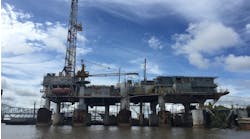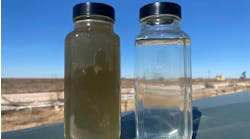bp affirms commitment to Gulf of Mexico with startup of Argos platform
Editor's note: This Gulf of Mexico column first appeared in the May-June issue of Offshore magazine. Click here to view the full issue.
By Bruce Beaubouef, Managing Editor
With a series of announcements made this year, bp has shown its commitment to E&P in the US Gulf of Mexico.
In mid-April, the company reported that it had successfully started oil production at its Argos offshore platform, delivering more energy at a critical time and strengthening its position as a leading producer in the deepwater US Gulf of Mexico.
With a gross production capacity of up to 140,000 barrels of oil per day, Argos is bp’s fifth platform in the Gulf of Mexico and the first new bp-operated production facility in the region since 2008. Argos is the centerpiece of bp’s Mad Dog Phase 2 project, which extends the life of the “super-giant” oil field discovered in 1998.
The semisubmersible platform ultimately will increase bp’s gross operated production capacity in the Gulf of Mexico by an estimated 20%. The company says that it expects to safely and systematically ramp up production from Argos through 2023.
Operating in 4,500 feet of water about 190 miles south of New Orleans, bp says that Argos will support 250 permanent jobs. Standing 27 stories tall, the platform has a deck the length and width of an American football field and weighs more than 60,000 tons.
Argos is bp’s most digitally advanced platform operating in the Gulf of Mexico, featuring bp’s proprietary LoSal Enhanced Oil Recovery and Dynamic Digital Twin technologies. Argos has a waterflood injection capacity of more than 140,000 barrels of low-salinity water per day to help increase oil recovery from the Mad Dog field.
The platform also has a Dynamic Digital Twin, a bp patent-pending software that links complex data from Argos to 3D digital models of those systems, allowing remote operators wearing Virtual Reality headsets to access data in real time to improve decision-making, efficiency and safety.
Starlee Sykes, who recently served as bp’s senior vice president, Gulf of Mexico and Canada, said: “Safely starting up the Argos platform is an incredible milestone for bp and a proud moment for our team who delivered the project with an impeccable safety record. Producing some of bp’s highest value, lowest operational emissions barrels, our Gulf of Mexico business has an important role to play in delivering the energy the world needs.”
Ewan Drummond, senior vice president, projects, production and operations, said: “Argos is key to our strategy of increasing our Gulf of Mexico production to around 400,000 barrels of oil equivalent per day by the middle of this decade.”
And bp has been affirming its commitment to the Gulf in recent months. Earlier this year, the company announced plans to invest a total of $7 billion into E&P activities in the Gulf of Mexico by 2025, compared to $10 billion in investment over the past five years. The investment figure amounts to an annual average of $2.3 billion in the Gulf of Mexico in the 2023-25 period, up from the $2 billion annual investment seen over the past five years.
As laid out in its “US Impact Report: Investing in America,” the company said that it aims to increase production in the Gulf of Mexico from about 290,000 boe/day in 2021 to around 400,000 boe/day by the mid-2020s. It also said that it expects to cut emissions by 20% in the region by 2030.
Several new projects are underway, including a $1.3-billion expansion at the Atlantis field in the Gulf of Mexico, the $9-billion Mad Dog 2 development, and a major expansion at the Thunder Horse field.
Back in January, bp’s Gulf of Mexico & Canada team achieved a milestone when the company’s largest platform in the GoM, Thunder Horse, safely hit a production target of more than 200,000 boe/d for the first time in over a year.
Thunder Horse is an integrated production and drilling facility with a dual derrick drilling rig located 150 miles southeast of New Orleans. It operates in a water depth of 6,050 ft. Thunder Horse can produce up to 250,000 bbl/d of oil and up to 200 MMcf/d of natural gas.
In an interview with Offshore in April, Sykes affirmed bp’s ongoing interest in the US Gulf of Mexico. “The Gulf of Mexico is an incredible basin; I’ve heard it called many times a ‘super basin,’” she commented. “And we continue to advance technology that can unlock these reserves. High-pressure/high temperature equipment is quickly becoming industry-proven technology. And bp has done a lot of work on seismic technology to the point where we can, in many cases, see below the salt layer, and thus have more certainty about our geologic targets. And all of that continues to evolve. So from a geologic perspective, I think the Gulf of Mexico has massive running room.”




